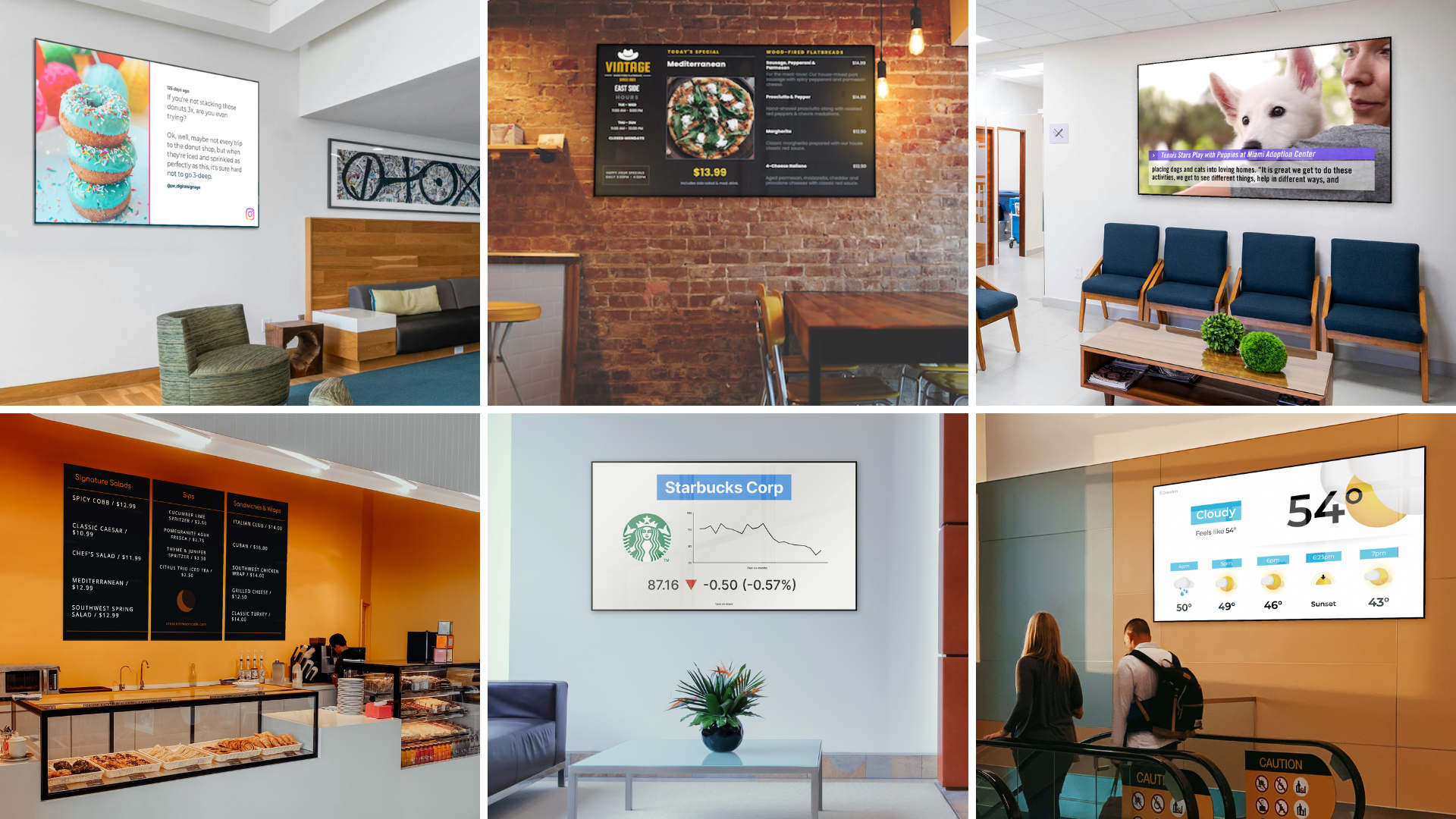Digital signage is one of the most effective ways of delivering a message to an audience in any venue.But digital signage content is the key to unlocking and driving value! Don’t invest in a network setup just to have it ignored by audiences.
A winning digital signage content strategy involves:
- Knowing your content options
- Knowing your audience & aspirations/goals
- Knowing your brand
- Knowing your capacity
In this post, we’ll cover available content options you should know about. We’ll also use ABCs (Audience & Aspirations, Brand, and Capacity) for easy content decision making. After, you’ll be empowered to make effective content choices for your displays and venue.
Consider Content Options & Resources
The first step to form a winning content strategy is being familiar with different types of digital content options and resources. Popular content categories and use cases include:
- Advertisements
- Brand videos
- Calendars
- Countdowns
- Customer testimonials
- Employee birthdays & anniversaries
- Events
- Flight and transit information
- Fun facts
- Health indices
- Inspirational quotes
- KPI metrics
- Meeting room bookings
- Menu boards
- News
- Promotional images and videos
- Social media
- Sports scores & schedules
- Traffic
- Trivia
- Wayfinding
- Weather
- Welcome messages
You can get this content in a variety of ways. Most are available as subscriptions. Others are made custom in-house, or by an integrator that creates and manages content like EcoDigital. Hone in on the choice(s) that are right for you by reflecting on your audience & aspirations, brand, and management capacity.
Consider Audience & Aspirations
What is your goal of using digital signage displays? This answer should be audience-centric. It will be personal to each group or business. It will also be the foundation of further content decisions.
Perhaps on a college campus, the goal is to make students feel welcomed, help them find their way and retain enrollment year after year. Content used for corporate communications might encourage employees and cultivate an uplifting in-office experience.
Hospitality content will immerse visitors in a surrounding community and offer easy navigation around an unfamiliar place. Entertainment content can decrease perceived wait times or calm patients in a waiting room or line queue.
Utilizing good news stories can create a positive distraction in healthcare settings.
Effective content strategy will educate, inform, or entertain viewers (or a combination of the three.) It will serve the viewer, serve your business goals, and cater to the venue.
Consider Your Brand
How important is it to feature company branding on-screen? You may opt for custom-made content, or subscribe to content outside of your brand depending on the answer.
There are cases in which it’s most effective to utilize brand recognition. Displaying stories from a trusted news source, or accurate weather data, is a great example.
News from the Associated Press.
Other strategies are entirely based on promoting a brand. This is particularly effective in retail, service, restaurant, and hospitality environments. In this case, custom templates can be created to highlight and promote branded images and other relevant information.
As a baseline, most digital signage content options will allow the setting of colors and fonts, or adding a logo. If a more custom look is needed, commissioning a custom template or creating content in-house may be the appropriate choice.
Consider Your Capacity
Content freshness and relevance will make or break a strategy or set goals. If screens aren’t serving new content to viewers at a consistent rate, screens will be ignored.
First ask, can an in house team create new images or videos on a daily or weekly basis to keep screens fresh? If not, consider a partner with experience. Many options exist for easy ongoing content management. Most groups will opt for subscription content or custom-built templates that update automatically for a portion of their playlist.
Providers will offer subscription-based content that’s updated as often as every 5 minutes, or multiple times daily or weekly. Local weather constantly updates to reflect current or upcoming conditions without external intervention:
Provide a reliable look ahead with licensed weather content.
Or, custom templates can be used. These templates will integrate live data and update on set intervals. For example, a digital display of team KPIs and calendars. Or, displaying point of sale system information on a digital menu board.
POS system integrations on digital menu templates can reflect price differences, new items or promotions
If opting for an in-house management approach, make sure individuals or teams have the capacity to update content at a consistent rate, if not include a partner like EcoDigital to support content virtually.
Defining your Overall Content Strategy
Now, it’s time to put everything together! First, take inventory of different content types available. Decide which of those will interest or benefit your audience.
Also consider what goals the content on screen is supporting. Use those goals to narrow your content choices down to those aligned with the outcome you’re aiming for.
For the look and feel, weigh how important it is to show company branding (or other trusted brands.) Finally, gauge the capacity of your existing team to maintain on-screen content.
You can now define the content type you want, the source and design of that content, and if you’ll be using a partner or provider for ongoing management.
The end result will be an intentional, enduring, and successful content strategy. Ultimately, your screens will stay fresh and support key business objectives with these factors in mind.
For strategy advice, reach out to Screenfeed or the EcoDigital team. We’d be happy to help define, or re-define, your content strategy!




